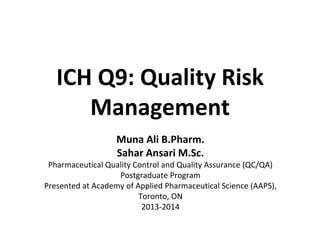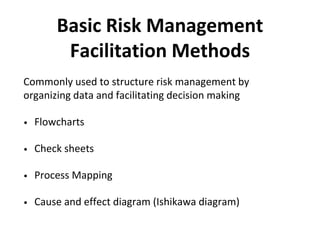ICH Guideline Q9 - Quality Risk Management
- 1. ICH Q9: Quality Risk Management MunaAli B.Pharm. SaharAnsariM.Sc. Pharmaceutical Quality Control and Quality Assurance (QC/QA) Postgraduate Program Presented at Academy of Applied Pharmaceutical Science (AAPS), Toronto, ON 2013-2014
- 2. Risk Management The systemic application of quality management policies, procedures and practices to the tasks of assessing, controlling, communicating and reviewing risk.
- 3. Principles of Quality Risk Management 1.The evaluation of the risk to quality should be based on scientific knowledge and link to the protection of the patient 2.The level of effort, formality and documentation of the quality risk management process should be of the same level/measure of risk
- 4. Quality Risk Management Team ŌĆóExperts from the appropriate areas (e.g. quality unit, business development, engineering, regulatory affairs, production and sales) ŌĆóIndividuals who are knowledgeable about the quality risk management process
- 5. Overview of a typical quality risk management process
- 6. Initiating a Quality Risk Management Process ŌĆóDefine the problem and/or risk ŌĆóAssemble background information on the potential hazard, harm or human health impact ŌĆóIdentify a leader and necessary resources ŌĆóSpecify a timeline and appropriate level of decision making
- 7. Risk Assessment A systemic process of organizing information to support a risk decision to be made within a risk management process
- 8. Risk Assessment Three fundamental questions for clearly defining the risk(s) 1.What might go wrong? 2.What is the probability it will go wrong? 3.What are the consequences?
- 9. Risk Identification The systemic use of information to identify potential sources of harm referring to the risk or problem
- 10. Risk Analysis The estimation of the risk associated with the identified hazards. It is the qualitative or quantitative process of linking the probability of occurrence and severity of harm
- 11. Risk Evaluation The comparison of the estimated risk to given risk criteria using a qualitative or quantitative scale to determine the significance of the risk
- 12. Risk Control ŌĆóActions implementing risk management decisions ŌĆóThe purpose is to reduce the risk to an acceptable level ŌĆóThe amount of effort used in risk control should be proportional to the significance of risk
- 13. Risk Control ŌĆóIs the risk above an acceptable level? ŌĆóWhat can be done to reduce or eliminate risks? ŌĆóWhat is the appropriate balance between benefits, risks and resources? ŌĆóAre new risks introduced as a result of the idetified risks being controlled?
- 14. Risk Reduction ŌĆóActions taken to lessen the probability of occurence severity of the harm ŌĆóRisk reduction measures might introduce new risks into the system or increase the significance of other risks ŌĆóRevisit risk assessment to identify and evaluate any possible change
- 15. Risk Acceptance ŌĆóThe decision to accept the risk ŌĆóThe best quality risk management might not entirely eliminate risk ŌĆóThe quality risk is reduced to a specified acceptable level which will decided on a case-by-case basis
- 16. Risk Communication ŌĆóThe sharing of information about risk and risk management between the decision maker and other stakeholders ŌĆóParties could coomunicate at any stage of the process ŌĆóThe output/result should be appropriately communicated and documented
- 17. Risk Review ŌĆóReview or monitoring of output/results of the risk management ŌĆóThe process should be utilized for events (planned or unplanned events) ŌĆóThe frequence of any review should be based on the level of risk ŌĆóRisk review might include reconsideration of risk acceptance decisions
- 18. List of recognized risk management tools ŌĆóBasic risk management facilitation methods ŌĆóFailure Mode Effects Analysis (FMEA) ŌĆóFailure Mode, Effects and Criticality Analysis (FMECA) ŌĆóFault Tree Analysis (FTA) ŌĆóHazard Analysis and Critical Control Points (HACCP) ŌĆóHazard Operability Analysis (HAZOP) ŌĆóPreliminary Hazard Analysis (PHA) ŌĆóRisk ranking and filtering ŌĆóSupporting statistical tools
- 19. Basic Risk Management Facilitation Methods Commonly used to structure risk management by organizing data and facilitating decision making ŌĆóFlowcharts ŌĆóCheck sheets ŌĆóProcess Mapping ŌĆóCause and effect diagram (Ishikawa diagram)
- 20. Failure Mode Effect Analysis (FMEA) ŌĆóAn evaluation of potential failure modes and their likely effect on outcomes and/or product performance ŌĆóIt is a powerful tool for summarizing the important modes of failure, factors causing these failures and the effect of these failures ŌĆóPotential Areas of Use(s) 1.To prioritize risks and monitor effectiveness of risk control activities 2.To analyze manufacturing operation and its effect on product or processes
- 21. Failure Mode Effects Analysis (FMEA)
- 22. Failure Mode, Effects and Critically Analysis (FMECA) ŌĆóFMEA extended to incorporate an investigation of the degree of severity of the consequences, their probabilities of occurrence and their detectability ŌĆóPotential Areas of Use(s) 1.For failures and risks associated with manufacturing processes 2.The output of FMECA is a relative risk score for each failure mode and is used to rank the modes of failure
- 23. Failure Mode, Effects, and Critically Analysis (FMECA)
- 24. Fault Tree Analysis (FTA) ŌĆóIt is an approach that assumes failures of the functionality of a product or process ŌĆóThis tool can combine multiple causes of failure by identifying casual chains ŌĆóPotential Areas of Use(s) 1.To establish the pathway to the root cause of the failure 2.To investigate complaints and deviations in order to fully understand their root cause 3.For evaluating how multiple factors affect a given issue 4.Useful for risk assessment and in developing monitoring programs
- 25. Hazard Analysis and Critical Control Points (HACCP) ŌĆóIts is a structured approach that applies technical and scientific principles to analyze, evaluate, prevent and control the risk due to the design, development, production, and use of the products ŌĆóPotential Areas of Use(s) 1.To identify and manage risks associated with physical, chemical and biological hazards (including microbiological contamination) 2.Useful when product and process understanding is sufficiently comprehensive to support identification of critical control points
- 26. Hazard Analysis and Critical Control Points (HACCP)
- 27. Hazard Operability Analysis (HAZOP) ŌĆóHAZOP is based on a theory that assumes that risk events are caused by deviations from the design or operating intentions. ŌĆóPotential Areas of Use(s) 1.Applied to manufacturing processes 2.The output of a HAZOP analysis is a list of critical operations for risk management which facilitates regular monitoring of critical points in manufacturing process
- 28. Preliminary Hazard Analysis (PHA) ŌĆóIt is a tool of analysis based on applying prior experience or knowledge of hazard or failure to identify future hazards that might cause harm ŌĆóPotential Area of Use(s) 1.Analyzing existing system or prioritizing hazards 2.Used early in the development of a project where there is little information on design, details or operating procedures
- 29. Preliminary Hazard Analysis (PHA)
- 30. Risk Ranking and Filtering ŌĆóIt is a tool for comparing and ranking risks which requires the evaluation of multiple quantitative and qualitative factors for each risks ŌĆóThis tool involves in breaking down a basic risk question into as many component as needed to capture factors involved in the risk ŌĆóPotential Areas of Use(s): 1.Used to prioritize manufacturing sites for inspection/audits by regulators or industry 2.Useful when management needs to evaluate both quantitatively-assessed risks and qualitatively-assessed risks within the same organizational framework
- 31. Supporting Statistical Tools ŌĆóStatistical tools can enable effective data assessment, aid in determining the significance of the data set(s) and facilitate more reliable decision making ŌĆóList of some of the principal statistical tools used in the pharmaceutical industry: 1.Control Charts 2.Control Charts with Arithmetic Average and Warning Limits 3.Histograms 4.Pareto Charts 5.Process Capability Analysis
- 32. Conclusion ŌĆóQuality Risk Management is a process that supports science-based and practical decisions when integrated into quality systems ŌĆóIt provides documented and reproducible methods to accomplish steps to the quality risk management process ŌĆóAppropriate use of quality risk management does not eliminate industry's obligation to comply with regulatory requirements.
- 33. References ŌĆóhttp://www.ich.org/fileadmin/Public_Web_Site/ICH_Products/Guidelines/Quality/Q9/Step4/Q9_Guideline.pdf ŌĆóhttp://eurogtps.com/PROJECTOUTCOMES/EuroGTPHOTTOPICS/4RISKMANAGEMENT/44Relevantdefinitionsintheriskmanagementpr/tabid/246/Default.aspx ŌĆóhttp://www.fmea-fmeca.com/fmea-examples.html ŌĆóhttp://www.emeraldinsight.com/journals.htm?articleid=1463554 ŌĆóhttp://www.qualitytrainingportal.com/resources/problem_solving/problem-solving_tools- fault_tree.htm ŌĆóhttp://www.beverageonline.com/doc/gary-ades-on-food-safety-haccp-haccp-haccp-pa- 0004 ŌĆóhttp://www.oshatrain.org/notes/2bnotes18.html
- 34. Questions?
- 35. Thank You


































